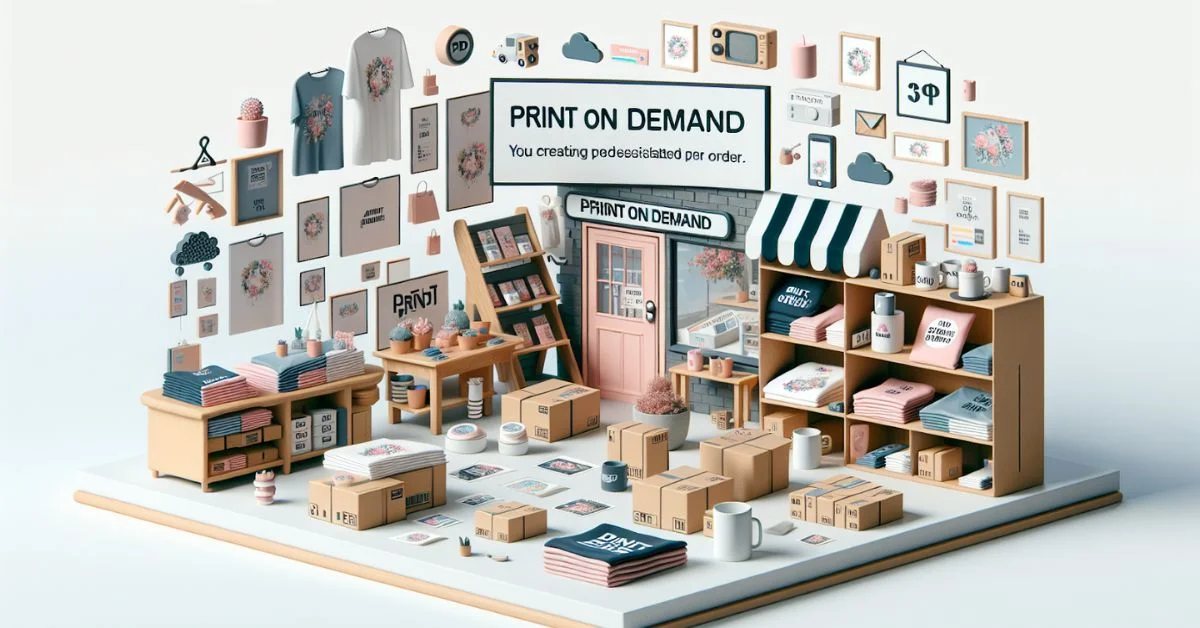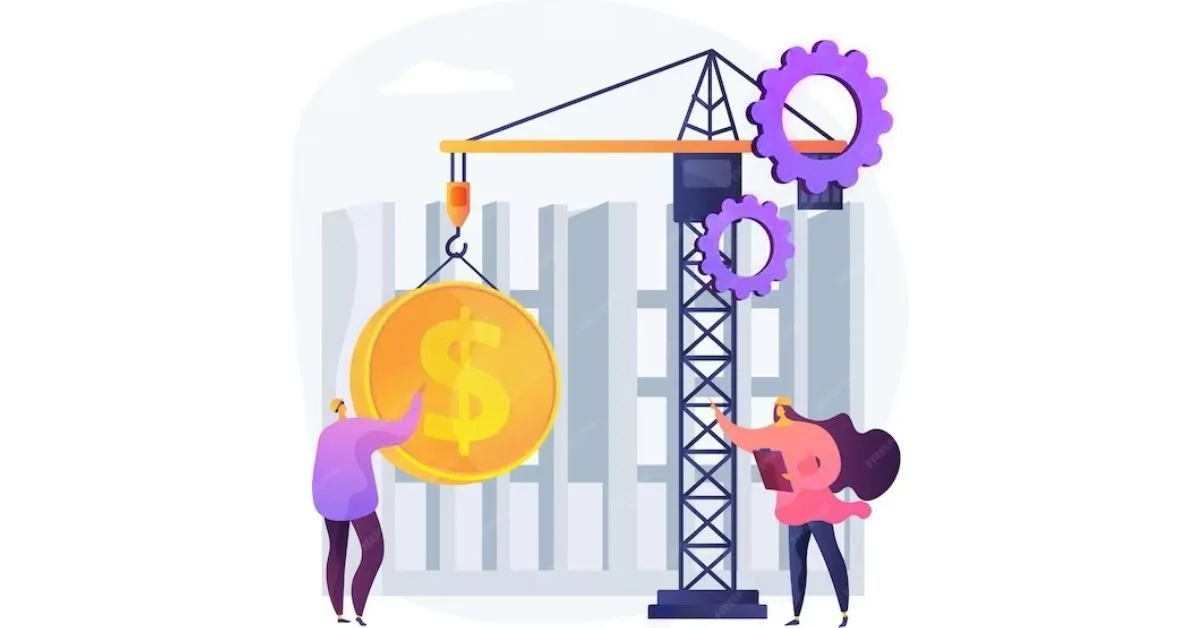BUSINESS
Top Print on Demand Platforms Compared: Etsy vs. Amazon vs. Shopify

The digital realm presents vast opportunities for entrepreneurs, and one of the most accessible entry points is the print on demand (POD) business model. Untethered from the traditional requirements of inventory management and large upfront costs, print on demand has revolutionized the way artists, designers, and small businesses approach e-commerce.
Understanding Print-On-Demand
Print on demand is a fulfillment method where items are printed and shipped only after a sale has been made. This model dramatically reduces the risks associated with overproduction and storage, making it ideal for small businesses and individual creatives. With POD, you can offer a wide range of products, from apparel to home decor, without the need for bulk orders or storage space. The POD process is relatively simple: A customer places an order, the order is sent to a POD company, and they print, pack, and ship the product directly to the customer, often with the seller’s branding.
Advantages and Challenges
One of the main advantages of print on demand is the ability to launch products with minimal investment. It’s ideal for testing new product ideas or designs without the financial risk. The personalized nature of POD also provides a unique opportunity for niche marketing and building a brand around specific interests or communities. However, challenges include less control over product quality and fulfillment speed, potential for smaller profit margins due to higher unit costs, and the need for strong marketing efforts to stand out in a crowded market.
Overview of Platforms: Etsy, Amazon, and Shopify
When it comes to choosing a platform to sell POD products, Etsy, Amazon, and Shopify are among the top contenders. Each platform offers different advantages depending on your business model, audience, and objectives. Etsy is known for its community of creatives and unique, handmade items. Amazon boasts an enormous customer base and a robust infrastructure, including their own POD service, Merch by Amazon. Shopify, on the other hand, empowers sellers with complete control over their storefront and a wide array of integration options with POD services.
Etsy and Print-On-Demand
How Print-On-Demand Works on Etsy
Etsy has cultivated a marketplace that’s synonymous with unique, handcrafted items. Incorporating print on demand into an Etsy shop allows sellers to maintain the platform’s bespoke feel while utilizing the benefits of POD. Sellers can create custom listings for their designs, and when a customer makes a purchase, the order details are forwarded to the POD service, which then handles the production and shipping.
Integration with POD Services
Etsy functions well with several POD services that seamlessly integrate into their platform, such as Printful and Gooten. This integration allows for a relatively automated process, with these services syncing product listings, managing inventory, and updating the sellers about the order status without requiring continuous oversight from them.
Pros and Cons for Sellers
Selling on Etsy provides access to a ready-made audience that values uniqueness and quality. The platform’s focus on craftsmanship can help POD products stand out. However, Etsy charges listing and transaction fees, and as the marketplace becomes more crowded, standing out among competitors can be increasingly difficult.
Amazon and Print-On-Demand
Amazon’s Print-On-Demand Services
Amazon steps into the print-on-demand game with its own service, Merch by Amazon. This platform enables designers to sell their creations on Amazon’s vast marketplace without ever having to handle physical products. Once accepted into the program, sellers upload their designs, choose product types and colors, and set their prices. The products are listed on Amazon, tapping into its massive audience.
Merch by Amazon Overview
Merch by Amazon is an invite-only platform that takes care of everything from printing to customer service. It’s relatively hands-off for sellers, making it an attractive option for those who want to focus primarily on design and marketing. Plus, as products are listed directly on Amazon, they benefit from the marketplace’s powerful search and recommendation algorithms.
Pros and Cons for Sellers
The potential reach on Amazon is unparalleled, but competition is fierce, and gaining visibility can be challenging for new sellers. Merch by Amazon offers royalties on sales, which may be lower than profit margins on other platforms, but it compensates for this with volume and ease of use.
Shopify and Print-On-Demand
Utilizing Shopify for POD
Shopify stands out as an e-commerce platform that offers complete control over the branding and customer experience. With Shopify, sellers build their own online stores and can use a range of POD apps to create and sell custom products. Shopify’s open architecture allows sellers to finely tune their store’s look, feel, and functionality, which is vital for brand identity.
Connecting with POD Apps and Services
Shopify is compatible with a multitude of POD apps, such as Printify, Printful, and others, which can be easily integrated into any Shopify store. These apps allow sellers to design products, automate order fulfillment, and manage inventory without leaving the Shopify environment.
Pros and Cons for Sellers
Shopify’s greatest strength — control over the storefront — can also be a challenge for non-technical users who may find the setup and maintenance of a Shopify store daunting. However, this platform provides greater profit margins, as sellers avoid marketplace fees and can set their own prices. They must also drive their own traffic, which requires significant marketing efforts.
Comparing Print-On-Demand Features
Product Customization Options
In the world of print on demand, product customization is a key differentiator. Etsy offers the possibility to create personalized orders directly through customer-seller communication. Amazon’s custom feature is less pronounced but focuses on the quality and breadth of its product catalog. Shopify, with its range of apps, provides the most flexibility in product customization, enabling sellers to offer a variety of options and tailor products to their customers’ preferences.
Product Quality and Selection
Quality and selection are essential for customer satisfaction and repeat business. On Etsy and Shopify, the quality and selection depend largely on the chosen POD service provider. Amazon, through Merch by Amazon, has streamlined quality control with its own fulfillment process, ensuring a consistent level of product quality. Still, sellers are limited to Amazon’s product range.
Printing and Fulfillment Processes
The fulfillment process needs to be efficient and reliable to maintain customer trust. Etsy and Shopify rely on third-party POD services to handle fulfillment, which may lead to variations in production times and quality. On the other hand, Amazon’s robust logistics network typically ensures faster and more predictable fulfillment, though customization options might be more restricted.
Ease of Use and Integration
Setting Up Storefronts with POD
Setting up a storefront on Etsy is simple, requiring only a good understanding of the platform’s rules and an eye for appealing product presentation. Amazon simplifies the process further by integrating it into the overall Amazon selling experience, although getting accepted to Merch by Amazon can take time. Shopify, while offering greater control, requires a fair bit of setup and may warrant a learning curve or professional help for those unfamiliar with e-commerce platforms.
Integration with Existing Online Stores
For those already running online stores, integration with POD services is a critical aspect. While Etsy operates as a standalone marketplace, Shopify excels in providing seamless integrations with existing websites. Amazon, albeit a standalone platform, also offers the possibility to use its fulfillment services for orders taken elsewhere through the Fulfilled by Amazon (FBA) program.
User Experience for Sellers and Customers
From navigation to checkout, user experience is paramount. Etsy has honed a customer-friendly interface known for its ease and community feel. Amazon provides a tried-and-tested buyer journey that’s familiar to millions of users. Shopify, while customizable, places the onus on sellers to create a smooth and engaging user experience from the ground up.
Earnings and Pricing Structure
Cost Considerations for Sellers
Cost is a critical consideration when choosing a POD platform. Etsy and Amazon charge transaction fees, which can eat into profits, but they also bring substantial traffic to listings. Shopify requires a monthly subscription, and while it has no sales fees, sellers must consider costs for apps, themes, and possibly paid marketing to attract traffic.
Profit Margins on Each Platform
Profit margins can vary widely across platforms. On Etsy and Amazon, higher traffic may lead to more sales but at the cost of lower margins due to fees. Shopify sellers can enjoy higher margins, assuming they’ve successfully driven sufficient traffic to their stores and optimized their pricing strategies effectively.
Price Setting and Control
Control over pricing is crucial for maintaining profitability. Etsy and Amazon provide a framework within which sellers must operate, often resulting in competitive pricing strategies. Shopify stands out again as it offers sellers full control over their pricing, which can be adjusted based on costs, competition, and customer demand, making it possible to optimize for profit.
Marketing Your POD Business
Strategies for Etsy
Marketing on Etsy requires a combination of SEO optimization for Etsy’s search engine, engaging product photography, and tapping into the platform’s active community. Building a strong brand presence and utilizing social media can also drive external traffic to an Etsy shop.
Leveraging Amazon’s Reach
Amazon is a behemoth when it comes to customer reach. Success here depends on understanding Amazon’s complex SEO, ad platform, and leveraging the power of customer reviews and competitive pricing to climb the ranks and potentially earn a coveted “”Amazon’s Choice”” label.
Marketing Tools and SEO on Shopify
For Shopify users, diversifying marketing strategies is key. This includes optimizing the storefront for search engines, leveraging email marketing, using social media strategically, and experimenting with paid ads if the budget allows. Shopify’s analytics and marketing app integrations can offer valuable insights into buyer behavior and campaign effectiveness.
Customer Service and Support
Seller Support on Each Platform
Seller support can greatly influence the decision of where to host a POD business. Etsy is known for its supportive community and seller forums. Amazon provides a vast knowledge base and support system, yet it can be impersonal due to its size. Shopify shines with extensive documentation, a responsive support team, and a vibrant developer community that’s always ready to help.
Handling Customer Inquiries and Issues
Good customer service is crucial for any business’s success. Etsy and Amazon manage much of the customer service on the seller’s behalf, but this can mean less control over the resolution process. Shopify sellers have to handle customer service themselves, which can be a burden but also an opportunity to provide a personalized touch.
Return Policies and Satisfaction Guarates
Return policies and satisfaction guarantees are important considerations for customers. Etsy allows sellers to set their own policies, while Amazon has a comprehensive return policy that customers trust. Sellers using Shopify have the freedom to create their policies, which must balance customer satisfaction with the business’s viability.
Conclusion and Recommendations
Choosing the Best POD Platform for Your Needs
Choosing the best platform for your print on demand business will depend on various factors, including your technical expertise, marketing strength, product range, and the level of control you desire. Each platform has unique strengths and limitations, from Etsy’s creative community to Amazon’s vast audience and Shopify’s customization abilities.
Balancing Costs, Features, and Market Reach
When comparing Etsy vs. Amazon vs. Shopify, there’s no one-size-fits-all answer, but there are trade-offs to consider. Etsy and Amazon offer substantial market reach and relatively lower setup costs, but with less profit margin and control. Shopify necessitates more upfront effort and marketing savvy but offers the highest potential margins and brand autonomy.
Final Thoughts on Growing a POD Business
Ultimately, growing a successful POD business requires a strategic approach to product development, market research, and customer satisfaction, regardless of the platform. Carefully weighing the advantages and challenges of each can help you align your business objectives with the platform best suited to meet your needs. Whether you opt for the community-driven environment of Etsy, the massive marketplace of Amazon, or the entrepreneurial freedom of Shopify, success in POD comes down to understanding your audience, mastering the platform’s nuances, and consistently delivering quality products with exceptional service.”
BUSINESS
Tips for Choosing the Right Yard Waste Dumpster Rental

When it comes to managing yard waste, having the right dumpster rental can make a world of difference. Whether you’re tackling a landscaping project or simply cleaning up your outdoor space, having a convenient and efficient way to dispose of yard waste is essential.
With numerous options available, it’s important to know what to look for when choosing a yard waste dumpster rental.
Here are some valuable tips to help you make the right decision.
Assess Your Needs
Before you dive into searching for a yard waste dumpster rental, pause for a second to think about what you need. Think about how much yard waste you think you’ll end up with and the size of the stuff you’re tossing out. This will give you a good idea of what size dumpster you should go for. Rental services usually have different sizes to choose from, so knowing your needs will make picking one a breeze.
Research Local Providers
Before selecting a yard waste dumpster rental, it’s crucial to research local providers thoroughly. Explore this dumpster rental service in Delaware for insights on what to consider when choosing a rental company near you. Delve into reviews, compare pricing, and evaluate services provided. Ensuring you secure the most advantageous deal available while upholding quality is paramount.
Consider Sustainability
Going green is not only good for the environment, but it can also save you money on your rental. When searching for a yard waste dumpster rental, consider asking if they have environmental considerations in their waste management process or if they recycle the waste they collect. This will not only reduce your carbon footprint but may also result in lower fees.
Consider Pricing and Terms
When you’re checking out various yard waste dumpster rental choices, make sure to think about the pricing and terms. Look for clear pricing options with no sneaky fees, and ask about any extra charges for delivery, pickup, or going over weight limits.
Also, keep an eye on how long you can rent it and any rules about what kind of yard waste you can toss in. Knowing the ins and outs of the rental deal will help you dodge surprises and make sure your rental goes without a hitch.
Choose the Right Size
Choosing the perfect dumpster size is key for handling yard waste like a pro. If it’s too small, you’ll end up with overflow and extra charges; too big, you’re overspending. Think about how much waste you’ll have and pick a dumpster size that’s just right. Rental services usually have various options, so you can find the one that suits your needs best.
Prioritize Sustainability
When you’re renting a yard waste dumpster, think about going green. Check out dumpster rental services that give eco-friendly disposal choices like composting or recycling yard waste whenever they can. By picking a provider that cares about sustainability, you’re not just getting rid of waste, you’re helping out the planet too.
Making the Right Yard Waste Dumpster Rental Choice
Picking the perfect yard waste dumpster rental is a must for handling outdoor projects and keeping your outdoor area neat. By figuring out what you need, checking out local options, thinking about costs and terms, finding the right size, and focusing on sustainability, you can make sure renting goes smoothly.
Whether you’re sprucing up your yard or doing some landscaping, choosing the best dumpster rental service in your area will help you manage your yard waste well and in an eco-friendly way.
Share this article and other related content with your fellow readers as you continue exploring the articles on this site.
FINANCE
The Benefits of Utilizing Expert Tax Services for Managing Your 529 Plan

Navigating the complexities of a 529 Plan can feel overwhelming. Especially when considering tax implications. That’s where expert tax services come into play.
But what makes a tax accountant invaluable in this scenario? They bring clarity to intricate tax laws and regulations. By doing so, they ensure you’re compliant and maximizing your savings.
Their guidance becomes a beacon, illuminating the path to financial efficiency. In managing your 529 Plan, the expertise of a tax accountant is indispensable. They turn a daunting task into a manageable and strategic financial decision.
Understanding the Tax Benefits of a 529 Plan
529 plan is a type of savings plan that allows you to invest funds for future education expenses without incurring federal taxes on earnings or withdrawals. Many states offer additional tax incentives for contributing to a 529 Plan.
These can include deductions or credits on state income taxes. It makes it an even more attractive option for families saving for education expenses. Yet, it’s crucial to understand the specific tax benefits of your state’s plan.
It is where expert tax services come in. They have an in-depth understanding of state-specific tax laws and regulations. They take advantage of all available tax benefits.
The Expertise of Tax Accountants in Maximizing Savings
One of the benefits of utilizing expert tax services for your 529 education savings plans is their ability to maximize your savings. Tax accountants have a deep understanding of tax laws and regulations, including those specific to 529 Plans. They can help you navigate the complex tax implications of your contributions, earnings, and withdrawals from the plan.
This knowledge allows them to identify opportunities for tax savings. It ensures that you are compliant with all tax laws related to 529 education savings plans.
By leveraging their expertise, you can make informed decisions. It optimizes your financial benefits and secures your future educational savings.
Strategic Planning for Your 529 Plan
An expert tax service can help you develop a strategic plan for your 529 Plan. They can analyze your financial situation and determine the most helpful ways to contribute, invest, and withdraw funds from the plan.
Tax accountants can also guide how to coordinate 529 Plan contributions with other education-related tax benefits. These includes the following:
- American Opportunity Tax Credit
- Lifetime Learning Credit
Peace of Mind and Ongoing Support
Managing a 529 Plan can be a time-consuming and complex task. By utilizing expert tax services, you can have peace of mind knowing that your plan is being managed efficiently and effectively.
Tax accountants can also provide ongoing support and guidance as your financial situation changes or as new tax laws are implemented. It allows you to focus on other important aspects of your life while still ensuring that your 529 Plan is being managed in the most beneficial way possible.
Discovering the Benefits of Expert Tax Services
Expert tax services make 529 Plans manageable. They decode complex tax issues, revealing paths to savings. Their insight ensures compliance and optimizes your investment.
Affordable tax service transforms daunting tasks into strategic success. It’s about maximizing benefits while minimizing stress. Choose expert tax services for peace of mind.
They safeguard your educational savings, ensuring future success. Remember, investing in expert advice pays dividends in financial health.
Did you find this article helpful? If so, check out the rest of our site for more informative content.
REAL ESTATE
The Cost of Inflation in Construction

Since 2022 inflation has been driving up costs for just about everything, from bread to gasoline to construction costs and manufacturing. At just about every level, cost increases from 10 to 200 percent have been realized, sometimes adding three to four layers onto the original cost from the producer before reaching the final end user or customer. Construction in particular has been significantly hammered by inflation in multiple areas, depending on so many different supplies, skills, trades and products to complete a project. That cost increase ultimately has to get passed on to the commercial or industrial customer who may not be so willing to take on such increases if they can be delayed until the market is more reasonable.
How Can it Be Fixed?
The primary tool used by the government involves reducing the amount of currency in the market, thereby driving up the value of the dollar and reducing inflation’s effect. While easy to say, the implementation aspect is hard. It means increasing the cost of borrowing, making new money more expensive to obtain. Other methods involve reducing the number of income earners generating new value as well. That in turn results in job loss. The list goes on with a singular, common feature – pain. Most solutions for inflation tend to cause more loss, which is why inflation is often feared as a double-damage effect on an economy.
What Can Construction Do as a Solution?
One method of fighting inflation in the construction industry involves finding lower-cost substitutes for supplies and services used. However, this is a bit of a limited option; going too low ends up lowering the quality of the goods or services provided. Since the construction company is ultimately liable for the quality of the entire project delivery, there is a practical floor to how low quality can go before a discounted price isn’t worth taking. After all, the old saying of, “You get what you pay for,” really does apply in construction.
A second method involves financing the inflation as a delay tactic. The thinking here is to let someone else’s money take the hit of inflation through borrowing and, when times are better and currency valuation rises, the financing can be paid off with a lower cost. It is, in essence, gambling that the future will provide a better exchange for the borrower than the cost of the borrowing today. In many cases, this kind of financing out of inflation doesn’t work, and the cost of the construction ends up being far more.
A third method involves maximizing local resources, labor and equipment. While some construction companies insist on bringing all of their resources, cost-sensitive operations focus on finding the resources locally wherever the project happens to be. Again, there is a bit of gambling here; if the resources are not available locally, the company will still have to bring them in to complete the job. At short notice, that could drive the cost higher than if the elements were retained to begin with well in advance.
The Most Sensitive Construction Areas Hit
Among the areas hardest hit, raw material suppliers and equipment fleet managers have been seeing the most noticeable ongoing expense impacts. Fuel for vehicles erodes operating budgets mercilessly. Where construction involves a lot of transport, fuel costs are going to remain a challenge.
Most construction requires raw materials for assembly and end product development. As raw materials go up, the cost of the project increases notably. Materials can reach as much as 60 percent of a construction project’s overall expense, so controlling procurement is essential to protect profit margins. Yet again, the quality issue ties the project’s hands from going too cheap on supplies.
Finally, labor will continue to be a pressure during periods where hiring is difficult. Combined with inflation, deficits in skilled labor and trades can easily drive up salary and wage costs on a project, even with outsourcing and contracting versus direct hires.
Inflation Doesn’t Last Forever, Right?
Much of the expectation in the U.S. is that the current inflation levels will be temporary. However, Japan was a good example where long-lasting economic problems hampered multiple industries for a decade or longer. There’s no rule that says inflation can only last one or two years. Instead, monetary policy tends to be the primary response that makes a difference, reducing supply of currency and increasing economic buying power.

 ENTERTAINMENT4 days ago
ENTERTAINMENT4 days agoExploring the Kristen Archives: A Treasure Trove of Erotica and More

 ENTERTAINMENT1 day ago
ENTERTAINMENT1 day agoKiss KH: The Streaming Platform Redefining Digital Engagement and Cultural Currents

 EDUCATION1 day ago
EDUCATION1 day agoLingrohub Platform: A Complete Student Access Guide

 LIFESTYLE4 months ago
LIFESTYLE4 months agoThe Disciplinary Wives Club: Spanking for Love, Not Punishment

 TECHNOLOGY24 hours ago
TECHNOLOGY24 hours agoCasibom: The Digital Alchemy Reshaping Systems, Society, and Self

 TECHNOLOGY23 hours ago
TECHNOLOGY23 hours agoSecuring Your Online Presence: The Ultimate Guide to Buying an SSL Certificate

 LIFESTYLE23 hours ago
LIFESTYLE23 hours agoTips for Prolonging the Lifespan of Truck Roll-Up Door Rollers

 TECHNOLOGY4 months ago
TECHNOLOGY4 months agoBlog Arcy Art: Where Architecture Meets Art











